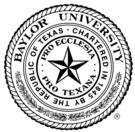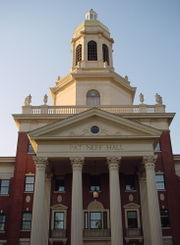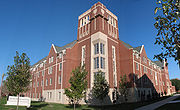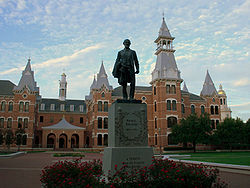Baylor University
| Baylor University | |
|---|---|
 |
|
| Motto | Pro Ecclesia, Pro Texana (Latin for "For Church, For Texas") |
| Established | 1845 |
| Type | Private, Baptist |
| Endowment | $1,068,934,000 (June 2010)[1] |
| President | Kenneth Starr |
| Provost | Dr. Elizabeth Davis (interim) |
| Academic staff | 859 [2] |
| Students | 14,769 [2] |
| Undergraduates | 12,149 [2] |
| Postgraduates | 2,620 [2] |
| Location | Waco, Texas, United States |
| Campus | Urban, 735 acres (3 km²) |
| Sports | Baylor Bears |
| Colors | Green and Gold |
| Nickname | Bears |
| Mascot | Bruiser & Judge |
| Affiliations | Big 12, Baptist General Convention of Texas, ASAIHL |
| Website | www.baylor.edu |
|
|
|
Baylor University is a private, Christian-affiliated research university located in Waco, Texas, United States. Founded in 1845, Baylor is accredited by the Southern Association of Colleges and Schools and is a member of the Big 12 Conference.[3][4]
Baylor is known for its programs in business, law, music, philosophy, theology, and science (see research below).The university campus is located just southeast of downtown Waco, roughly bounded by Interstate 35, La Salle Avenue, Eighth Street and the Brazos River.
Contents |
History

In 1841, 35 delegates to the Union Baptist Association meeting voted to adopt the suggestion of Reverend William Milton Tryon and R.E.B. Baylor to establish a Baptist university in Texas. Baylor, a Texas district judge and onetime US Congressman from Alabama, became the school's namesake.
In the fall of 1844, the Texas Baptist Education Society petitioned the Congress of the Republic of Texas to charter a Baptist university. Republic President Anson Jones signed the Act of Congress on February 1, 1845, officially establishing Baylor University. The founders built it in Independence. Reverend Matthew Hopkins, who had been the first Baptist missionary to Texas, was Baylor's first full-time fund-raiser. He is considered the third founding father of the university. Although these three men are credited as being the founders of the university, many others worked to see the first university established in Texas They were awarded Baylor's Founders Medal.[5]

In 1851, Baylor's second president Rufus Columbus Burleson decided to separate the students by gender, making the Baylor Female College an independent and separate institution. Baylor University became an all-male institution.
During the American Civil War, the Baylor president was George Washington Baines, maternal great-grandfather of the future U.S. President, Lyndon Baines Johnston. Baines was also later a trustee of Mary Hardin-Baylor. During the late nineteenth century, the city of Independence began suffering a decline, because of the rise of neighboring cities serviced by the Santa Fe Railroad.
Beginning in 1885, Baylor University moved to Waco, Texas, a growing town on the railroad. It merged with Waco University, where Baylor's former second president, Rufus Burleson, was serving as president. That same year, the Baylor Female College moved to Belton, Texas. It later became known as the University of Mary Hardin-Baylor. A Baylor College Park still exists in Independence in memory of the college's history there. Around 1887, Baylor University began readmitting women and became coeducational again.
In 1900, three physicians founded the "University of Dallas Medical Department", in Dallas, although a university by that name did not exist. In 1903, Baylor University acquired the medical school, which became known as the Baylor College of Medicine, while remaining in Dallas.
In 1943, Dallas civic leaders wanted to build larger facilities for the university in a new medical center, but only if the College of Medicine would surrender its denominational alliances with the Baptist state convention. The Baylor administration refused the offer. With funding from the M. D. Anderson Foundation and others, Baylor moved the College of Medicine to Houston.
After passage of the Civil Rights Act of 1964, the university was desegregated.[6] In 1969, the Baylor College of Medicine became technically independent from Baylor University. They still maintain close ties.
Baylor University and the Baylor College of Medicine have an agreement that provides for some Baylor undergraduates to be accepted to Baylor College of Medicine. Talks are underway to strengthen the affiliation between the two institutions, although a formal merger is not under consideration.[7]

In the late twentieth century, the Southern Baptist Convention had a major controversy between fundamentalists and moderates, with fundamentalists achieving control of the organization and replacing officials of many agencies. Similar actions took place in many state conventions as well. Concerned about potential effects on its governance, in 1991 Baylor University gained permission of the Texas legislature to change the terms of its charter. It established a governance less directly dependent upon the Baptist state convention, which administration had become increasingly fundamentalist. The state convention continues to elect one-quarter of the members of Baylor's Board of Regents, all of whom are required to be practicing Baptists.
Academics
Rankings
In 2010, U.S. News & World Report ranked the university 79th out of 262 national universities.[8] Highly ranked academic programs include the undergraduate business program at 38th place, and the entrepreneurship program at 14th place.[9] The University ranks in the top 15% of colleges and universities participating in the National Merit Scholarship program.[10]
Among schools in the Big 12 conference, Baylor University is ranked #3 academically. Baylor is the most selective college among the Big 12 schools, the 2009-2010 acceptance rate is 44%. [11] According to The Princeton Review, Baylor was ranked among the Best Western Colleges.[12] Additionally, the university has been ranked #12 for students with clean records. In addition, The Princeton Review ranked Baylor #4 for entrepreneurial programs.
The university first received school accreditation in 1914 when it became an accredited member of the Commission on Colleges of the Southern Association of Colleges and Schools.[13] The Baylor College of Medicine received accreditation from Southern Association of Colleges and Schools in 1970. It has had no official affiliation with Baylor University since 1969.[14]
Just over 50% of the university's faculty are tenured.[15]
Institutional organization

The university is divided into eleven degree-granting academic units. Two of the units are designated as colleges, while eight others are designated as schools. They are:
- College of Arts and Sciences
- Hankamer School of Business
- Honors College
- School of Education
- School of Engineering and Computer Science
- Graduate School
- Law School
- Louise Herrington School of Nursing
- School of Music
- School of Social Work
Additionally, the George W. Truett Theological Seminary is a unit of the university.
Presidents
During its more than 160 years of history, Baylor has had 13 presidents, whose leadership has shaped the growth of the institution (Interim presidents are noted):
|
|
(Note: While Rufus C. Burleson served as Baylor's President twice, he is counted only once in the presidential count. This makes Reddin Andrews the fifth president and Oscar Henry Cooper the sixth president. Additionally, the interim presidents are not counted in the presidential count.)
Baylor 2012
In 2000, the university sought to expand its vision of a scholarly institution. Under President Robert B. Sloan, Baylor created a written statement for its vision. This statement was appropriately titled, Baylor 2012, the year by which the school hopes to achieve its aims. The university's vision is to "enter the top tier of American universities while reaffirming and deepening its distinctive Christian mission."[16] The vision was presented to the Board of Regents in September 2001, and approved shortly afterward. The Vision is based upon twelve key imperatives designed to create a more fulfilling educational experience in a unique, scholarly environment. The twelve imperatives are:
- Establish an environment where learning can flourish;
- Create a truly residential campus;
- Develop a world-class faculty;
- Attract and support a top-tier student body;
- Initiate outstanding new academic programs in selected areas;
- Guide all Baylor students, through academic and student life programming, to understand life as a stewardship and work as a vocation;
- Provide outstanding academic facilities;
- Construct useful and aesthetically pleasing physical spaces;
- Enhance involvement of the entire Baylor family;
- Build with integrity a winning athletic tradition in all sports;
- Emphasize global education; and
- Achieve a two-billion dollar endowment.
Baylor 2012 has encountered opposition since its inception. Some allege that the Vision led to a polarization of faculty opinion, which culminated in the resignation of Sloan in June 2005. But, Baylor's Faculty Senate has unanimously endorsed Vision 2012 each time it has reviewed it. Opponents argue that the Vision will limit academic freedom and hinder intellectual growth due to an excessive focus on Christian interpretation.[17] Some critics also opposed the increase in tuition costs.
The university's administration has countered that increased tuition costs are comparable to those of other private universities. It said that preserving and strengthening Christian values at the university is of paramount importance. As of February 2006, the university has received a record number of applications from both freshmen and transfer students.[18]
Student life
For the fall 2009 semester, Baylor University had 12,149 undergraduate and 2,620 graduate and professional students in 151 baccalaureate programs, 76 masters, 30 doctoral, and 2 Educational Specialist programs. Baylor enrollment includes students from 49 states, the District of Columbia, and approximately 85 foreign countries. Baylor is among the 10% of US colleges and universities to have a Phi Beta Kappa chapter.[19]
Housing
Baylor offers several choices for on-campus living. As part of Vision 2012, Baylor strives to have a large percentage of students living on campus. Due to the rapid growth of the university, Baylor cannot keep up with the construction projects needed to accommodate the entire student body.
As of 2010, the university offers seven dormitories for incoming freshmen, and eleven dormitories in all. In addition to the dormitories, Baylor owns and operates four co-ed apartment complexes on the campus that are available for upperclassmen.
The first residence community to be built in more than 40 years was completed in 2004 as part of the Vision 2012. North Village, which houses 600 students of the Engineering School as well as upperclassmen, offers a more apartment-style option in three adjacent buildings. The community features a courtyard area, with a garden area and community center/study area and cafe.

In 2006, Brooks Hall, the oldest dormitory on campus, was demolished to make room for the new Brooks Village. It houses 716 students, more than three times as many as the former hall. The facility features a dining hall and a chapel. Nearby is a field for student activity use. The development includes Brooks Flats, on-campus apartments similar to North Village, and Brooks College, the first co-ed residential dormitory on campus. It is modeled after the residential college systems found at Cambridge University and other elite schools. In addition, a new 800-car parking garage was built across the street for the use by students 'living on the southern part of campus.
Because of the rapid growth in the university's student population, the current percentage of those living on campus is only 35 percent, with all residence facilities at capacity.
Traditional dorm-style residences are:
- Collins (female)
- Kokernot (Co-Ed, Engaged Learning Groups)
- Martin (male)
- North Russell (female)
- Penland (male)
- South Russell (female)
Suite-style residence halls are:
- Alexander (male - Honors Residential College)
- Allen (male - LEADERSHIP Living & Learning Center and Air Force ROTC Living and Learning Center)
- Brooks College (Co-Ed, divided into east and west)
- Dawson (female - LEADERSHIP Living & Learning Center and Air Force ROTC Living and Learning Center)
- Memorial (female - Honors Residential College)
Apartment-style living options are:
- North Village
- University House (male, academically gifted student housing, ECS-LLC, Outdoor Adventure LLC, Entrepreneurship LLC, Fine Arts LLC)
- Texana House (female, Entrepreneurship LLC, Fine Arts LLC)
- Heritage House (Co-Ed, divided into north and south, ECS-LLC)
- The Arbors
- Brooks Flats (GLOBAL COMMUNITY Living and Learning Center)
- Speight-Jenkins
Greek organizations
There are four councils at Baylor: the Multi-Cultural Greek Council, National Panhellenic Council, Interfraternity Council, and Panhellenic Council. There are over 24 fraternities, 6 Multicultural sororities, 3 National Panhellenic Council and 9 Panhellenic sororities at Baylor. Many of the Greek organizations were local clubs until 1976, when Baylor allowed national affiliations. Pi Beta Phi, started as Alpha Omega Club, is the oldest sorority on campus.
Today Baylor has many chapters of national Greeks and is home to several local Greek groups as well, such as Kappa Omega Tau and Phi Kappa Chi. Among Texas universities, Baylor has a high rate of male participation, with 25% involved in fraternities. But, unlike most universities which allow "Greek systems", Baylor does not permit them to have their own residences or fraternity houses.
Research and endowment
In 2005, the University was invited to join the Collider Detector at Fermilab (CDF) collaboration at the Fermi National Accelerator Laboratory in Batavia, Illinois.[20] The project is one of the world's largest experimental physics collaborations.
In 2006, the Carnegie Foundation upgraded the university's classification to "Research University" status with "High Research Activity," opening the door to many new research opportunities.[21]
In October of 2009, a group of state, county and city governments and organizations and higher educational institutions in Central Texas announced the creation of the Central Texas Technology and Research Park, and the park's first project, the Baylor Research and Innovation Collaborative (BRIC) to be housed in the former General Tire facility on South Loop Drive in Waco. Funding for the effort comes from the state of Texas and from Baylor University. Clifton Robinson donated the former General Tire facility to Baylor University to support the research collaborative.[22][23]
Several former and present faculty at Baylor are involved in the intelligent design debate, most notably philosopher William Dembski, now at Southwestern Baptist Theological Seminary, Christian philosopher Francis Beckwith, and electrical engineer Robert J. Marks II.[24][25]
The university's endowment passed $1 billion in 2007 and reached $1,055,478,000 on December 31, 2007.[26] Despite the economic crisis of 2008, Baylor spokesperson Lori Fogleman reported that Baylor's endowment grew 5.1% in the fiscal year ending June 30, 2008; the National Association of College and University Business Officials estimated that during that same period, the median return for the top 25% of college endowments decreased by 2.2%. Fogleman cited the university's long-term investments and diversified holdings as the cause of the endowment's recent success. As of December 2008, the Baylor endowment totaled less than $1 billion, down from a May high of $1.06 billion.[27][28] A consulting firm hired by the university expressed concern that the disagreements within the Baylor community could hinder the endowment from continuing its four-year streak of increased endowment donation totals and its 2012 goal of a $2 billion endowment, though the current economy may also prevent both.[29]
Athletics


Baylor's men's sports teams are nicknamed the Bears, and the women's teams are nicknamed the Lady Bears. Student athletes participate in the NCAA's Division I. Baylor is the only private school in the Big 12 Conference.
Prior to joining the Big 12, Baylor was a member of the Southwest Conference from the conference's charter in 1914 until its dissolution in 1996. Baylor has carried over its rivalries from the now-defunct Southwest Conference, the most important of which are with Texas, Texas A&M, and Texas Tech.
Baylor has won two NCAA titles. In 2004, the men's tennis team defeated UCLA in the championship game. In 2005, the Baylor Lady Bears basketball team beat Michigan State in the championship game.
Traditions
The Baylor Line
The Baylor Line is tradition at Baylor University. It is made entirely of freshmen and is at the heart of building Baylor spirit and tradition for new students. Freshmen wear a football jersey with the number of their proposed graduation year and a nickname on the back.
The Baylor Line gathers at one end of Floyd Casey Stadium before each football game and waits for the signal to rush the field. A sea of yellow jerseys covers the field complete with painted faces and acrobatics. Then the line creates a giant human tunnel that the football team runs through to enter the stadium. Ten members of the Baylor Line carry flags with the letters B-A-Y-L-O-R-L-I-N-E. The Baylor Line students rush the sidelines and stand in an exclusive Baylor Line section behind the opponents' bench. Students then cheer for Baylor and heckle the other team.
All University Sing
All University Sing is an annual spring semester variety show featuring clubs and organizations on campus. In 1958, Pigskin Revue was added as a Homecoming event that featured the best acts from the previous spring's competition. Up until 1963 the event was primarily groups singing in the style of a choir on a riser. Since then the event has grown to the include high energy Broadway style song and dance numbers. In 2003, Baylor celebrated 50 Years of Sing with commemorative books, DVDs and reunions.
Alma mater
Baylor's alma mater is That Good Old Baylor Line. In 1906 a student penned humorous words to the tune of "In the Good Old Summer Time" and they became generally accepted among the student body as the school fight song. However, in 1931, Enid Eastland Markham, wife of music professor Robert Markham, feeling the words were not dignified enough nor representative of the total University, wrote new lyrics which were presented in chapel in November and soon sanctioned as the official school song. The Good Old Summer Time tune was later arranged to fit Mrs. Markham's "Baylor Line" through the work of Jack Goode, Donald I. Moore and Charles F. Brown.
That Good Old Baylor Line;
that good old Baylor Line.
We'll march forever down the years
as long as stars shall shine.
We'll fling our green and gold afar
to light the ways of time
and guide us as we onward go.
That good old Baylor Line.
Diadeloso
Every spring since 1934, Baylor takes a Thursday off from classes for a spring holiday which since 1966 has been known as Diadeloso (Spanish for day of the bear). The Baylor University Chamber of Commerce organizes the event which consists of entertainment of all types - tug o' war contests, three-on-three basketball, ping pong, indoor soccer, board game tournaments, ultimate frisbee, multi-player console games, gospel choirs, etc. This tradition often baffles new professors because class is not in session.
Dr. Pepper Hour
Dr. Pepper Hour has been a Baylor tradition since 1953. About 500 students stop in every Tuesday from 3pm to 4pm in the Barfield Drawing Room of the Baylor Student Union (also known as The SUB) to pickup a free Dr. Pepper float. Originally featuring Coca-Cola, Baylor switched to Dr. Pepper in 1997 and now offers Diet Dr. Pepper as well. Free Dr. Pepper Floats are also very common at Baylor-sponsored events.[30]
Golden Wave Marching Band
The Baylor University Golden Wave Band (BUGWB) is the current halftime entertainment for Baylor football. The band attends every home football game at Floyd Casey Stadium. They also travel with the team to provide support at rival schools. The band attends all pep rallies in the fall. They march in the annual Homecoming Parade and other Homecoming events. With a current membership of 275 members, the Golden Wave Marching Band is dedicated to enhancing the Baylor Spirit.
Homecoming
Baylor celebrated its first homecoming in 1909 and it has become an annual event since then. It was the first ever homecoming and the invention of something that would be used by millions of other colleges to this day. Traditional activities include Pigskin Revue, a song and dance featuring the top acts from the previous spring's All University Sing; Freshman Mass Meeting, where freshmen hear the story of the Immortal Ten and are charged with guarding the Eternal Flame until the building of the bonfire; and a pep rally and bonfire on Friday evening. Baylor is also home to the oldest and longest collegiate homecoming parade in the U.S.[31] Since the mid 1930s, the Baylor Chamber has been responsible for funding, coordinating and executing the majority of the aspects of Baylor's Homecoming activities.
Immortal Ten
In January 1927 a bus carrying the Baylor basketball team collided with a speeding train in Round Rock, Texas. Ten members of the traveling party were killed and many others were injured in the accident. Each year at homecoming the story of the Immortal Ten is told again to the new freshman class at the Freshman Mass Meeting. The names of the ten are called out. In 1996, the senior class provided initial funding to create and place an Immortal Ten statue on campus. Fund raising and discussions about where to place the statues continued off and on over the ensuing years. Finally, on June 22, 2007, sculpture artist Bruce Greene's statues were unveiled. The Immortal Ten memorial was officially dedicated during the 2007 Baylor Homecoming on November 2 in Traditions Square.[32][33][34][35][36]
Mascot
The school mascot is the American black bear.
The first live bear was donated by local businessman Herbert E. Mayr in 1917 after winning the bear in a poker game with members of the 107th Engineer Battalion. Mayr had kept a bear cub as a pet and was often seen walking the cub near "The Circle" in Waco before he donated the animal to Baylor University. The Baylor University Chamber of Commerce is responsible for all aspects of the program including care, facility upkeep, and training. Currently there are two American black bears on campus named Judge Joy Reynolds and Judge Sue Sloan; students affectionately refer to them as "Joy" and "Lady".
The university recently finished renovation of the Bill and Eva Williams Bear Habitat, a $1 million facility which includes a thirteen-foot (four-metre) waterfall, three pools, two dens, grass, and eye-level viewing. The facility is a United States Department of Agriculture- licensed Class C zoo. Visitors can see the bears up close and learn more about North American black bears. The bear habitat is a favorite spot for visitors and students of all ages.
Night of the Organ
Night of the Organ is an annual Halloween organ concert that started in the 1990's and is hosted by Baylor's School of Music. The concert features many traditional Halloween songs in addition to a selection of contemporary picks played by Baylor Students. The concert is free and open to the public. A dessert reception typically follows, which features Baylor's only green Dr. Pepper Floats.
The NoZe Brotherhood
The NoZe Brotherhood, an unofficial fraternal organization founded in 1924, provides the university with unusual public pranks and satirical writings in its newspaper, The Rope. When in public as a NoZe brother, members wear traditional Groucho Marx-style mask disguises and outlandish costumes to keep their student identities secret. Faculty and students outside of the organization are typically split on their opinion of the group's humor. In some cases, the NoZe Brotherhood's actions and publications have been considered highly offensive and controversial by the Baylor community. Traditionally during commencement, NoZe Brothers will wear their glasses or have them around their necks as they receive their diploma to signify that they partook in the society.
University Mace
During the War of 1812, Cyrus Baylor, brother of R.E.B. Baylor, was cited for his bravery with the presentation of a gold sword by President Jackson. In 1957 it was given to the university. In 1974, Baylor president Abner V. McCall suggested that the sword be used to form the focal point of a ceremonial "symbol of authority". A timber from one of Old Main's towers was used to construct a base and center pole. Walking canes of former Baylor President Rufus C. Burleson and General Sam Houston, who had been baptized by Burleson and had been a supporter of the university, were linked to the sword to form the Mace. It is used at all university commencement exercises and at other special ceremonies.[37]
Baylor alumni
There are over 115,000 living Baylor alumni. Alumni and others associated with the university have had success in the fields of politics, arts, athletics, science, and scholarship.
Campus gallery
|
Clifton Robinson Tower west of Interstate 35 houses the Baylor administration offices. |
Pat Neff in the Spring, named for the former governor of Texas, Texas Railroad Commission member, and president of Baylor |
Bill Daniel Student Center from the side |
 Bill Daniel Student Center during Christmas |
 Tidwell Bible Building |
Baylor Science Building |
Truett Seminary |
 Mayborn Museum |
|
Burleson Quadrangle |
Old Main and Pat Neff Hall |
Corner of Pat Neff Hall |
 Pat Neff Hall looking west |
 Armstrong Browning Library from the outside |
 Statue of Judge Baylor |
 Another view of Burleson Quadrangle |
Another view of the Baylor Science Building |
References
- ↑ http://colleges.usnews.rankingsandreviews.com/best-colleges/waco-tx/baylor-university-6967
- ↑ 2.0 2.1 2.2 2.3 Office of Institutional Research and Testing (2009). "Fall 2009 Facts". Baylor University. http://www.baylor.edu/content/services/document.php/101538.pdf. Retrieved 2010-06-18.
- ↑ http://www.baptistschools.org/
- ↑ http://www.baptistschools.org/School_Search/body_school_search.html
- ↑ Baylor University || About Baylor || Founders Day
- ↑ Baylor University || The Lariat Online || News
- ↑ [1]
- ↑ "Best Colleges 2010 - Baylor University". U.S. News & World Report. http://colleges.usnews.rankingsandreviews.com/best-colleges/waco-tx/baylor-university-6967.
- ↑ Baylor University - Management & Entrepreneurship
- ↑ http://www.baylor.edu/irt/index.php?id=34195
- ↑ http://espn.go.com/blog/big12/post/_/id/238/the-big-12-ranked-in-academic-terms
- ↑ "Baylor University - The Princeton Review". http://www.princetonreview.com/BaylorUniversity.aspx.
- ↑ Results
- ↑ Results
- ↑ "Profile of Full-Time Faculty Fall 2005 and Fall 2006". Baylor University Office of Institutional Research & Testing. 2006-10-23. http://www.baylor.edu/content/services/document.php/36188.pdf. Retrieved 2007-03-26.
- ↑ Microsoft Word - 2012 Vision Final.doc
- ↑ Houppert, Karen (2005-12-01). "Professing Faith". Mother Jones. http://www.motherjones.com/news/feature/2005/12/professing_faith.html. Retrieved 2007-03-27.
- ↑ Fogleman, Lori (2006-02-06). "Soaring Freshman Applications Leads To Early Wait List". Baylor University. http://www.baylor.edu/pr/news.php?action=story&story=38804. Retrieved 2007-03-26.
- ↑ "Baylor University". Baylor University Office of Institutional Research and Testing. http://www.baylor.edu/content/services/document.php/101538.pdf. Retrieved 2010-03-30.
- ↑ Baylor University || Marketing & Communications || News
- ↑ "Baylor Reclassified by Carnegie Foundation as 'Research University'". http://www.baylor.edu/pr/news.php?action=story&story=40799. Retrieved 2008-06-22.
- ↑ http://www.baylor.edu/pr/news.php?action=story&story=63366
- ↑ http://www.wacotrib.com/opinion/QA-with-Dr-Truell-Hyde-on-the-formation-of-the-Baylor-Research-and-Innovation-Collaborative.html
- ↑ "Baylor avoids repeating an anti-ID purge from years before" by Mark Bergin World Magazine
- ↑ Baylor U. Removes a Web Page Associated With Intelligent Design From Its Site" by Elizabeth F. Farrell Chronicle of Higher Education Sept. 4, 2007.
- ↑ "Lilley: 2012 endowment goal may be too small". http://www.baylor.edu/lariat/news.php?action=story&story=48999. Retrieved 2008-06-22.
- ↑ "University quells financial concerns". The Baylor Lariat. 2008-12-03. http://www.baylor.edu/lariat/news.php?action=story&story=55012. Retrieved 2008-12-05.
- ↑ "Baylor officials: endowment weathering economic storm". The Waco Tribune. 2008-10-03. http://www.wacotrib.com/news/content/news/stories/2008/10/03/10032008wacbaylorendowment.html. Retrieved 2008-06-22.
- ↑ "In-fighting, economy may hurt endowment". The Baylor Lariat. 2008-10-02. http://www.baylor.edu/lariat/news.php?action=story&story=53334. Retrieved 2008-10-04.
- ↑ http://www.baylor.edu/pr/news.php?action=story&story=7140
- ↑ Baylor University || Homecoming
- ↑ Baylor's Immortal Ten finally get their statuary due
- ↑ Baylor University || Homecoming || Freshman Mass Meeting
- ↑ http://www.baylor.edu/about/index.php?id=5560
- ↑ Baylor Flashback - Jan. 22, 1927 - The Immortal Ten :: Exactly 80 years ago, Baylor tragically lost 10 athletes
- ↑ Baylor University || Marketing & Communications || News
- ↑ Baylor University || BUAA || Baylor Line || News
^ "Rouse in oblivion five years after Baylor scandal - Men's College Basketball". http://sports.espn.go.com/ncb/columns/story?columnist=oneil_dana&id=3371852&campaign=rss&source=ESPNHeadlines. ^ "Long journey home", Mike Waters, SI.com, January 5, 2007 Baylor University's Compilation of Related Press Releases The Dallas Morning News staff. "School reveals penalties." Quick (2004): 8–9. BaylorBears.com: Patrick Dennehy's Profile. ESPN.com: Coaches may have watched pickup game illegally, August 2, 2003. ESPN.com: Key dates in Dennehy disappearance, July 28, 2003. ESPN.com: NCAA memo details booster payments, other infractions, August 2, 2003. ESPN.com: Bliss Raises Bar For Unseemly Behavior Baylor University President Robert B. Sloan Jr.'s statement on NCAA violations, August 8, 2003. The NCAA's final report and list of punishments handed out to Baylor University, June 23, 2005. Retrieved from "http://en.wikipedia.org/wiki/Baylor_University_basketball_scandal"
External links
Official websites
- Baylor University
- Baylor Athletics
- The Honors Residential College of Baylor
- Armstrong Browning Library
- Mayborn Museum
- Baylor University Press
- Baylor Magazine
History
- History of Baylor University from the Handbook of Texas Online
- History of the Baylor College of Medicine from the Handbook of Texas Online
- History of University of Mary Hardin-Baylor from the Handbook of Texas Online
|
||||||||||||||||||||||||||||||||||
|
|||||
|
|||||
|
||||||||
|
|||||
|
||||||||